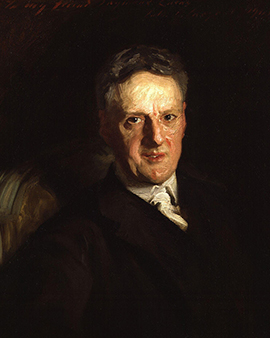


The Englishman John Seymour Lucas was a Victorian history and portrait painter. In addition to his successful career as a professional artist, Lucas worked as a costume designer at the theatre. He was born into an artistic family in London and was the nephew of the famous painter John Lucas. His son Sydney Seymour Lucas continued the family tradition and also became an artist.
Lucas completed an apprenticeship as a young man to become a woodcarver. The talented Englishman then studied portrait painting at St. Martin's Lane Art School and later at the Royal Academy School. In 1877 he married his fellow student, the French artist Marie Cornelissen. With his wife or often alone, he made extensive journeys through Europe. Lucas was particularly taken with Holland and Spain and the Flemish and Spanish masters.
As a historical genre painter with a distinct talent for realistic depictions of costumes and interiors, he was very popular among his contemporaries. Inspired by the paintings of Van Dyck and Diego Velázquez, Lucas liked to paint scenes from the British Tudor and Stuart period from the 16th to 18th century in the style of his models, including the English Civil War and the Jacobite uprisings.
Lucas' first painting that attracted wide attention was entitled "The Rebel Hunt for Culloden". Subsequently, his success grew among the more distinguished and wealthy social circles. The celebrated painter produced a number of important works for prestigious public buildings and royal patrons. These include: "The Charter of London" and "The Prince of Wales in German Uniform". Through his access to the elite class, Lucas met the distinguished portrait painter John Singer Sargent, who became his good friend and advisor. The portrait Sargant painted of his artist colleague Lucas is today in the collection of the Tate Britain. In addition to his prolific work as an oil and watercolour painter and draughtsman, Lucas established himself as a respected set and costume designer for historical dramas popular in the late Victorian and early Edwardian periods. One of his most spectacular costume designs was created by the creative mind for the play "Duke of Normandy", which Prince Alfred of Saxony Coburg-Gotha commissioned from the Devonshire Theatre in 1897.
Lucas worked most of his life in South Hampstead in a studio that the architect Sydney Williams-Lee had designed especially for him. At the end of the First World War Lucas retired from the art scene and moved to Blythburgh in Suffolk. Lucas died there in 1923.

The Englishman John Seymour Lucas was a Victorian history and portrait painter. In addition to his successful career as a professional artist, Lucas worked as a costume designer at the theatre. He was born into an artistic family in London and was the nephew of the famous painter John Lucas. His son Sydney Seymour Lucas continued the family tradition and also became an artist.
Lucas completed an apprenticeship as a young man to become a woodcarver. The talented Englishman then studied portrait painting at St. Martin's Lane Art School and later at the Royal Academy School. In 1877 he married his fellow student, the French artist Marie Cornelissen. With his wife or often alone, he made extensive journeys through Europe. Lucas was particularly taken with Holland and Spain and the Flemish and Spanish masters.
As a historical genre painter with a distinct talent for realistic depictions of costumes and interiors, he was very popular among his contemporaries. Inspired by the paintings of Van Dyck and Diego Velázquez, Lucas liked to paint scenes from the British Tudor and Stuart period from the 16th to 18th century in the style of his models, including the English Civil War and the Jacobite uprisings.
Lucas' first painting that attracted wide attention was entitled "The Rebel Hunt for Culloden". Subsequently, his success grew among the more distinguished and wealthy social circles. The celebrated painter produced a number of important works for prestigious public buildings and royal patrons. These include: "The Charter of London" and "The Prince of Wales in German Uniform". Through his access to the elite class, Lucas met the distinguished portrait painter John Singer Sargent, who became his good friend and advisor. The portrait Sargant painted of his artist colleague Lucas is today in the collection of the Tate Britain. In addition to his prolific work as an oil and watercolour painter and draughtsman, Lucas established himself as a respected set and costume designer for historical dramas popular in the late Victorian and early Edwardian periods. One of his most spectacular costume designs was created by the creative mind for the play "Duke of Normandy", which Prince Alfred of Saxony Coburg-Gotha commissioned from the Devonshire Theatre in 1897.
Lucas worked most of his life in South Hampstead in a studio that the architect Sydney Williams-Lee had designed especially for him. At the end of the First World War Lucas retired from the art scene and moved to Blythburgh in Suffolk. Lucas died there in 1923.
Page 1 / 1






